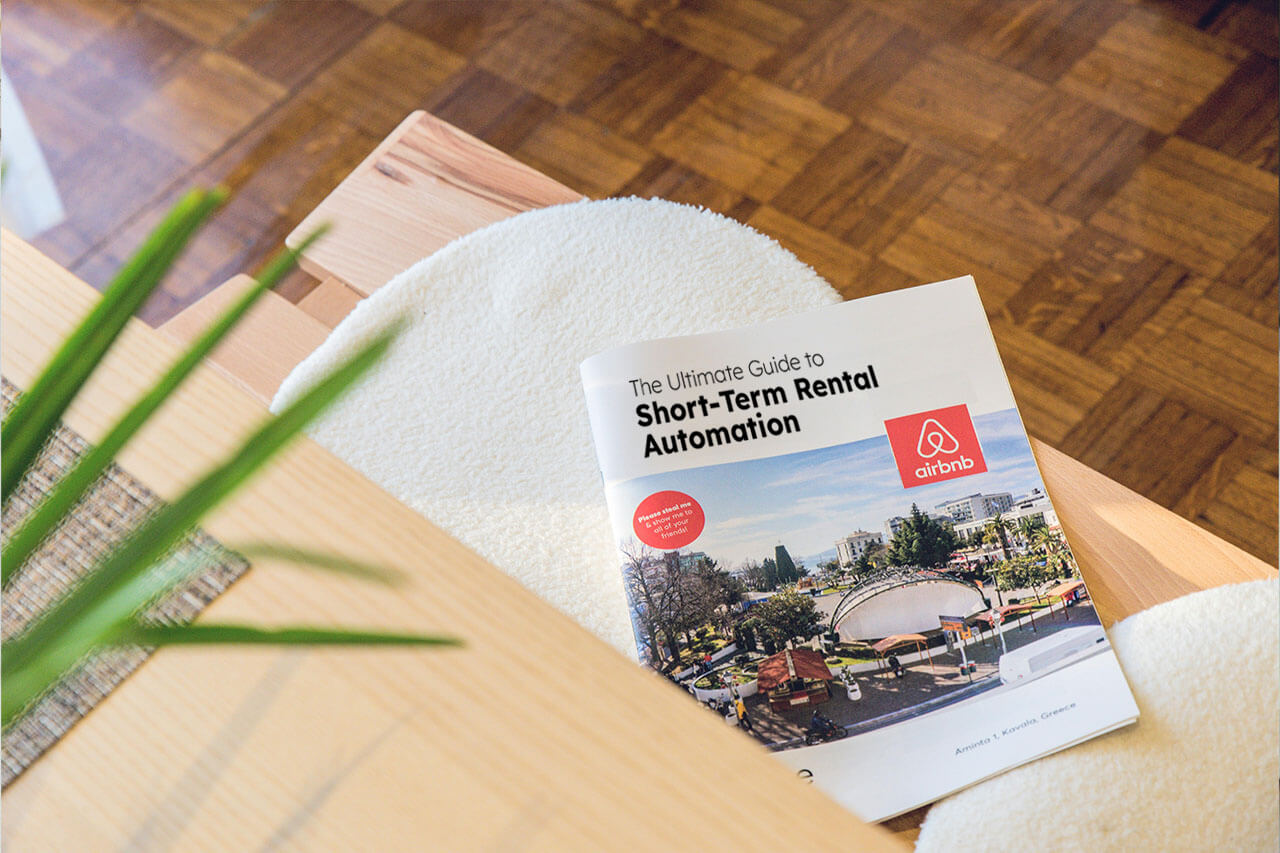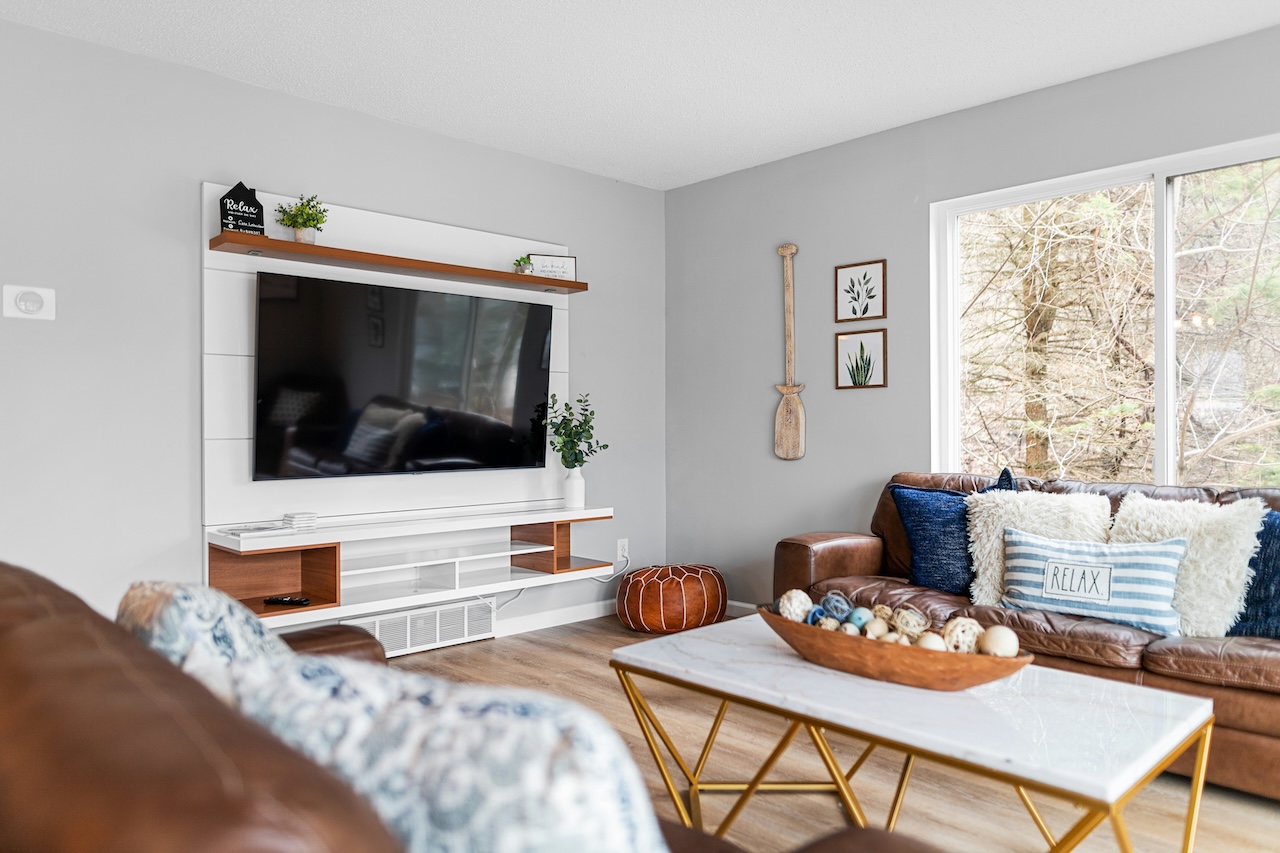Summary: Short-term rental automation blends operational tools—for cleaning, pricing, messaging, and maintenance—with smart-home systems—for locks, HVAC, lighting, water, and safety—synchronized with your booking calendar. Done right, your property prepares itself, reduces utility costs, and runs with far fewer headaches.
In this guide, we’ll walk through both the operational and smart-home sides of automation, show how they work together, and give you clear steps to build your own fully automated rental.
What Is Short-Term Rental Automation?
Short-term rental automation is the integration of software and connected devices to prepare, protect, and reset a property before, during, and after each stay—without constant manual intervention. Unlike a typical smart home, short-term rentals deal with frequent turnovers, variable occupancy, and remote management, requiring automation that is calendar-aware and optimized for hospitality.
The system rests on two main pillars:
- Operational Automation Tools – Platforms that streamline workflows: cleaning schedules, guest communications, pricing adjustments, and maintenance tracking.
- Smart-Home Automation Systems – Devices that control access, climate, lighting, water, and safety sensors.
Together, these pillars create a self-managing property that delivers consistent guest experiences and lower operational costs. First let’s explore the two pillars of automation in detail so you can understand how each works individually and in tandem. Then, we’ll walk through real-life examples, ROI potential, step-by-step setup, advanced strategies, and common pitfalls to avoid.
Pillar One: Operational Automation Tools
Operational automation removes repetitive coordination work, allowing you to focus on strategy and guest experience. Let’s break down the main areas:
Cleaning & Turnover Scheduling
Before guests even arrive, cleanliness sets the tone. Use tools like Breezeway or Properly to:
- Automatically assign cleanings right after check-out.
- Provide cleaners with photo-based checklists and staging standards.
- Sync cleaner-only door codes with your booking calendar.
Outcome: Faster turnovers, fewer missed cleans, and consistent presentation. Learn more in Airbnb Cleaning Automation.
Revenue Management (Dynamic Pricing)
Pricing is the heartbeat of your rental’s profitability. Pricing tools like PriceLabs, Wheelhouse, or Beyond:
- Adjust nightly rates based on demand, seasonality, and local events.
- Apply pricing rules to protect your floors/ceilings.
Outcome: Higher RevPAR with less manual intervention. See How to Make Money with Short-Term Rentals.
Guest Communication & Messaging
Your guest experience hinges on communication. Automate:
- Pre-arrival welcome guides and access details.
- Mid-stay check-ins and rule reminders.
- Check-out instructions and review requests.
Maintenance & Work Orders
Prevention is better than repair. Trigger maintenance tasks from:
- Guest-reported issues via forms or chat.
- Device alerts (e.g., leaks, low batteries).
- Seasonal schedules like HVAC filter changes.
Now that we’ve covered the business-side automations that keep operations smooth, let’s look at the smart-home systems that physically prepare and protect your property.
Pillar Two: Smart-Home Automation Systems
While operational tools streamline workflows, smart-home systems control the physical environment. Rental Home Automator integrates all devices—including valves and switches—from one platform, billed by location instead of device count.
Smart Locks
- Guest codes activate at check-in and expire at check-out.
- Cleaner/vendor codes only work within assigned time windows. See Best Smart Locks for Short-Term Rentals.
Climate Control
- Pre-condition the property before guest arrival; switch to eco mode at check-out.
- Pause HVAC if doors/windows are left open. See Thermostat Automation for Vacation Rentals.
Water Valves & Leak Detection
- Water automatically turns off when vacant and on during stays.
- Auto-shutoff triggered by leak detection. Read more in Water Valve Automation.
Lighting & Energy Management
- Create arrival lighting scenes at dusk.
- Sync exterior lights to sunset and booking calendar. See Lighting Automation for Short-Term Rentals.
Safety & Environment
- Monitor noise levels to prevent parties.
- Smoke and CO detection for guest safety.
How the Two Pillars Work Together
Now that we’ve defined the pillars, let’s discuss how they work in tandem to ensure your short-term rental is optimized.
- Pre-Arrival: Cleaner completes turnover → welcome message sent, water shut off.
- Check-in: At or a pre-defined time ahead of check-in → HVAC set to comfort, water turned on, lights on, access codes activated.
- During Stay: Noise threshold exceeded → automated guest message sent; repeat triggers security task.
- Check-out: Codes expire, HVAC to eco, water shut off, lights off, cleaning task created.
- Mid-Stay Leak: Leak detected → water shut off, maintenance notified, log created.
- Extended Vacancy: Lights and HVAC run minimal schedules, water remains off, freeze protection enabled.
By connecting operational and smart-home tools, each stage of the guest journey becomes smoother and more efficient.
Now that we’ve covered the two main pillars of short-term rental automation, the next sections will cover ROI, how to get started, advanced strategies and common pitfalls.
ROI: Savings and Revenue
Savvy investors know how to evaluate their return on investment, either in terms of cost reduction or revenue generation. Fortunately, short-term rental automation ROI provides us with the opportunity to both realize savings and generate additional revenue.
Direct Savings:
- Energy: Reduce utilities by 10–30%.
- Damage Prevention: Avoid multi-thousand-dollar repairs by keeping water off during vacancies and by establishing early leak detection.
- Labor: Reduce manual calls/texts and emergency trips.
Revenue Lift:
- More 5-star reviews from consistent service.
- Higher booking conversion with clear instructions and smooth stays.
Typical Payback: Many hosts see full ROI in 1–3 billing cycles.
Getting Started: A Step-by-Step Plan
This section details exactly how to launch automation in your rental, starting from foundational steps to advanced layering. This structured approach helps you avoid pitfalls and maximize gains.
- Define Goals – Target your top pain points.
- Stabilize Wi-Fi & Hub – Reliable connectivity is non-negotiable. See Why the UniFi Ecosystem is your Airbnb’s Soulmate.
- Start with High-Impact Devices – Locks → Thermostat → Water Valve → Lighting.
- Connect Your Calendar – Make automation event-based.
- Layer in Operational Tools – Add pricing, messaging, and maintenance automation.
- Standardize Checklists & Scenes – Ensure consistent staging.
- Measure & Iterate – Monitor utilities, incidents, and reviews.
By following these steps sequentially, you’ll avoid common pitfalls (covered below) and see faster results.
Advanced Strategies for Short-Term Rentals
After getting the basic automations set up, additional more advanced automations can always be added. Here are some of the advanced strategies you can consider:
- Vacancy Modes: Deep setbacks for long gaps; freeze protection for winter.
- Portfolio Templates: Replicate automation across properties.
- Edge Case Handling: Automatic adjustments for late check-outs/early arrivals.
- Compliance & Privacy: Outdoor cameras only; transparent policies.
Common Pitfalls (and How to Avoid Them)
There are lots of different ways to implement automation at your short-term rental or Airbnb. Watch out for the following common pitfalls:
- Overuse of Wi-Fi Devices: Use Z-Wave/Zigbee/Matter for critical automations. See What is the Best Smarthome Automation Protocol.
- Timer-Based Logic: Timers can conflict with bookings; use calendar triggers.
- One-Off Automations: Template your workflows.
- No Reset Routine: Always reset property after guest departure.
Explore Our Short-Term Rental Automation Collections
If you’re ready to go deeper into specific areas of short-term rental automation, we’ve organized our complete library of guides into topic-focused collections. These will help you master each aspect of automation step-by-step:
- Getting Started – Learn the fundamentals of short-term rental automation, from basic concepts to the first devices and tools every host should set up. Perfect for beginners who want a clear roadmap.
- Automation 101 – Practical tutorials and walkthroughs for setting up booking-aware automations, integrating devices with your PMS, and creating a hands-off guest experience.
- Device Reviews – Expert reviews of smart locks, thermostats, lighting, water valves, and more—so you can choose the best devices for reliability, security, and guest satisfaction.
- Operations Advice – Strategies for streamlining cleaning, maintenance, and guest communication to keep your property running efficiently and profitably.
- Miscellaneous – Infrastructure tips, advanced compatibility insights, and unique use cases to solve niche hosting challenges.
Pro tip: These collections are designed to be browsed in any order—so whether you’re outfitting your first property or optimizing a multi-unit portfolio, you can jump straight to the topics that matter most to you.
Frequently Asked Questions
Simply put, it’s the coordination of operational tools (cleaning, pricing, messaging, maintenance) and smart-home devices (locks, HVAC, lighting, water, safety) that act on your booking calendar. Consequently, your property prepares itself before arrival, safeguards itself during the stay, and resets itself at checkout.
Not necessarily. Although a PMS helps at scale, many core automations (locks, thermostats, lighting, water) can run directly from your calendar. Later, you can layer in PMS features for deeper reporting and multi-property workflows.
Start with smart locks (no key exchanges, fewer coordination errors), thermostats (10–30% utility savings are common), and a water shutoff valve (prevents catastrophic damage). Then, naturally expand to lighting and safety sensors.
• Smart locks → Best Smart Locks for Short-Term Rentals
• Thermostats → Thermostat Automation
• Water valve → Water Valve Automation
Because automation shortens response times, enables instant self-check-in, and improves review consistency, your listing quality improves. In turn, platforms reward that with better visibility, which often leads to higher occupancy and more direct bookings.
Often yes. As long as you choose hubs/devices with local control, essential actions (like access codes already on the lock) continue to work. Meanwhile, design lightweight fallbacks—e.g., a keypad code for cleaners and a physical lockbox for rare edge cases.
Absolutely. Since the system is calendar-aware, it can activate access codes, pre-condition HVAC, and notify cleaning immediately after the reservation is confirmed—even if the booking arrives hours before check-in.
As a rule, use outdoor-only cameras, disclose everything transparently, and avoid indoor cameras in guest spaces. Furthermore, limit staff/vendor access to what’s necessary, and keep advanced controls host-only.
Yes. In fact, a platform like Rental Home Automator unifies mixed brands so locks, HVAC, lighting, water valves, and sensors behave as one system—triggered by stays, not just timers. Consequently, you’re free to choose the best device per job.
Cleaner codes only work inside scheduled windows; completion can trigger “ready for guest” scenes (HVAC to comfort, arrival lights, etc.). Likewise, vendor codes can be time-boxed for maintenance appointments to protect guest privacy.
• Cleaning guide → Airbnb Cleaning Automation
Because false positives can hurt the guest experience, we recommend calendar-controlled water on/off (on during stays/cleans, off when vacant) plus leak sensors for alerts. This approach minimizes risk while avoiding mid-stay shutoffs.
• Details → Water Valve Automation
Track three streams: utilities (HVAC/lighting reductions), incident costs (water-damage avoidance), and operations (time saved, fewer trips). Additionally, monitor conversion, review keywords, and occupancy to quantify revenue lift.
Week 1: stabilize Wi-Fi/hub; connect calendar.
Week 2: deploy locks + thermostat; test stay triggers.
Week 3: add water valve + leak sensors; create reset scenes.
Week 4: integrate cleaning + messaging; document checklists and edge cases.
Yes. With location-based billing and reusable templates, you can standardize policies across properties while still tailoring local rules (e.g., climate by region). As a result, onboarding the next unit becomes drastically faster.
Browse our collections to level up methodically:
• Getting Started – fundamentals and first devices.
• Automation 101 – step-by-step, booking-aware setups.
• Device Reviews – locks, thermostats, lighting, water, and more.
• Operations Advice – cleaning, maintenance, messaging.
• Miscellaneous – infrastructure/compatibility tips.
Short-term rental automation isn’t just about adding gadgets—it’s about building a predictable, efficient, guest-friendly system that works for you 24/7. When operations and devices are aligned with your booking calendar, you reduce stress, protect your property, and elevate guest satisfaction.
Hosts who adopt automation early often find they can scale to more properties without adding equivalent workload, giving them a competitive edge in their market. And as technology continues to evolve, the potential for even deeper integration—like AI-driven pricing tied to real-time occupancy sensors—will only grow.
If you want a platform that automates all your smart devices (including valves and switches) and scales by location


